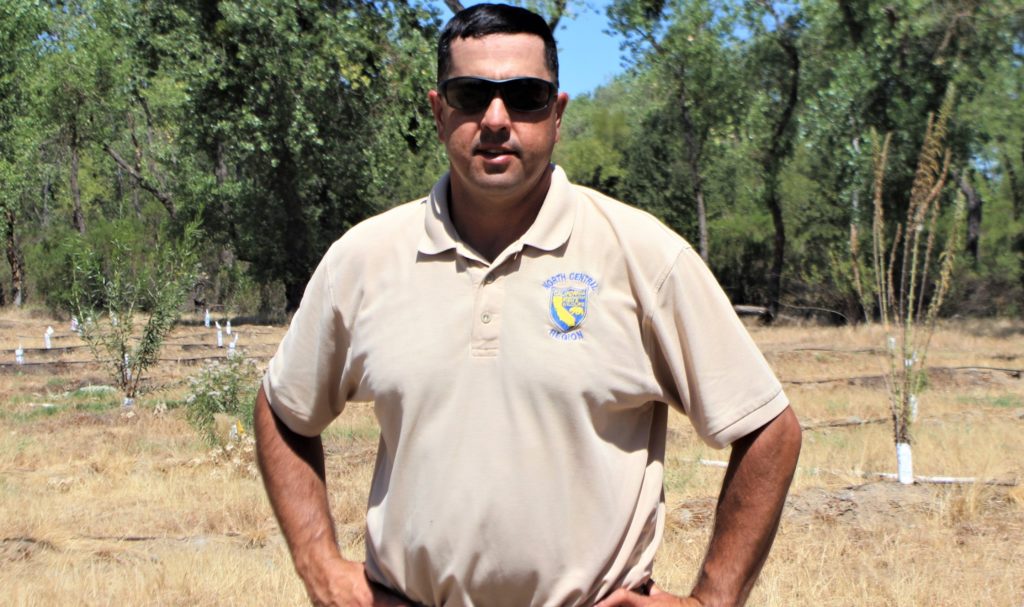
Kim Armstrong misses the monarchs. Over the past decade, most notably the past five years—working at Oroville Wildlife Area as a scientist for the California Department of Fish and Wildlife (CDFW), as well as the Chico-based nonprofit River Partners—she’s seen “a rapid decline” in the number of monarch butterfly caterpillars on the blossoms of milkweed plants. Her observations correlate with broader California data indicating a 99.9 percent decline of western monarchs since the 1980s.
Implications transcend the butterflies themselves.
“Monarchs are important [because] they’re kind of an iconic keystone species,” Armstrong told the CN&R on a recent morning at the wildlife area. “They’re a really good indicator for problems in the ecosystem, but they’re also just a large, colorful butterfly that the public can get involved in appreciating and conserving—and when you conserve an area for one species, you’re inadvertently conserving an area for a lot of other species.”

That’s what Armstrong, a restoration biologist, is doing with colleagues at the Oroville Wildlife Area. It’s one of eight sites around California—four in the North Valley—where River Partners and several organizations are restoring 595 acres of monarch habitat, funded by a $1.2 million California Wildlife Conservation Board grant.
The Oroville restoration covers two locations totaling 80 acres, where around 1,500 milkweeds have been planted and irrigated. This is the first to be completed. The other Nor-Cal sites are the Upper Butte Basin Wildlife Area near Chico (around 50 acres), Feather River Wildlife Area near Yuba City (40 acres) and the Yolo Bypass Area near Sacramento. The remaining sites are by Modesto, Bakersfield, Los Banos and San Diego.
“Monarchs are one of the few species of insects that most people can identify; it’s a species people know,” said Angela Laws, an endangered species conservation biologist with the Xerces Society, a group dedicated to protecting invertebrates. She and Washington State University biology professor Cheryl Schultz are designing the habitat plans and monitoring for the eight sites.
“I think because of their unique behavior—how they migrate, overwinter, form these clusters—it’s an amazing thing, and I think it really captures people’s imaginations,” Laws continued. “People feel emotionally connected to it. Just from doing outreach, I can tell you, people are passionate about this butterfly, and I think people are more aware of it than other species that might be declining just as much as monarchs are.”
Take native bees, monarchs’ fellow pollinators, as an example. Through extensive media coverage, many people know about the peril of honeybees, but far fewer know that California is home to 1,600 bee species. That morning at Oroville Wildlife Area, Laws found no monarchs on the new milkweeds, but tiny bees buzzed around the flowers—evidence of the side effect Armstrong called “inadvertently conserving an area for a lot of other species.”
Oroville Wildlife Area Manager A.J. Dill told the CN&R on-site that gauging success doesn’t hinge on butterfly counts.

“There are still places on this wildlife area that are barren moonscape from the dam area construction, all the way back to the mining days of yesteryear,” he said. “All this land was basically tossed away as wasteland; no benefit to the public. Here we are—60, 70 years later—we’ve got this whole ecosystem in the works.”
Causes and effects
Western monarchs, butterflies that migrate in the fall from the Rockies to the California coast, previously were prevalent, numbering around 4.5 million in the 1980s. But the most recent annual Western Monarch Thanksgiving Count—covering the 2020-2021 overwintering season— found less than 2,000 had come to spend the cold months, continuing a trend tracked by Xerxes Society researchers.
River Partners and the Xerces Society connect the population decline to losses of habitat. While pesticides have decimated honeybees, herbicides have hit monarchs. Milkweed, which often grew among crops, has declined across breeding grounds as farmers adopted plants genetically modified to withstand weedkiller, predominantly Roundup.
A Sacramento judge ruled in November that insects are not covered under the California Endangered Species Act, and the U.S. Fish and Wildlife Service determined in December that protecting monarchs under the federal Endangered Species Act “is warranted but precluded.”
All these factors cue the habitat project.

“Restoration is a process,” Laws said. “We’re not just going to flip a switch and now it’s perfect habitat. We’re in the process of improving this area, and over time we’ll see more and more pollinators come out.
“We’ve seen a couple different species of native bees today, some native flies that are really important pollinators. So there’s diversity out here, and as this planting becomes more established, as there’s more flowering, I think we’re going to see more pollinators.”
Added Dill: “Part of it is the activity level [at the project areas]. There’s a lot of activity right now. Once the plants take off on their own, it’s going to be different.”
Cultivation at the Oroville site began last June. Laws said the dry winter and heat of spring and summer impacted milkweeds’ blooming. Planting at Upper Butte Basin will start this fall.
Laws and her fellow researchers will regularly survey the sites to look for signs of monarchs, from caterpillars to full butterfly clusters.
In any case, she continued, “for a lot of these sites, they’re going to be a lot better than the control [i.e., unrestored areas], which would have been just invasive grasses that provide no floral resources for monarchs or other pollinators. So, it’s an improvement, for sure.”




I have a big patch of milkweed in Concow. I’ve seen a couple of male monarchs this year and no females. This patch has been here for years and the first time this late in summer i have seen so few monarchs
I saw a monarch heading south in my backyard the other day, so the migration has begun. I live in the Midwest, and it was heading to Mexico. I have tried to get milkweed plants started, but I have not been able to get them to grow, even though they were once everywhere here. I did get three echinacea plants to bloom out front, but I have only had one monarch stop by it all the years the plants have been out there.
Our biosphere is in trouble. Check it out. Walk over to a lush, fragrant flower garden and see for yourself. Of course, it varies from region to region, but the consensus is in: the bugs are dying, too.
In the fall of 1975, I took a geology class at Chico State, Geology 114. I know this because I have referenced it several times (my transcript is right close by in a filing cabinet).
In 1975, we learned about the environment and its stewardship. For our class project, we sent copies of our textbook to state senators in Sacramento. I can’t know if it did any good, but we now have bug sprays to kill cockroaches neurologically. Have you seen the commercial? We are more intelligent than bugs. Ain’t it grand?
I hope we can save such a beautiful butterfly and it’s so fasinating how this beautiful butterfly can migrate 3000 miles to get where it’s going and 3000 miles back and navigation by the sun